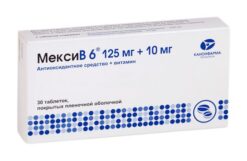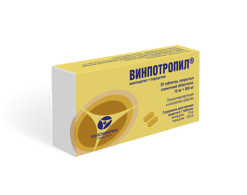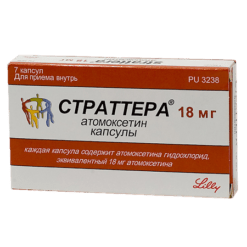-
×


-
×


-
×


-
×


Subtotal: €77.29








Subtotal: €77.29








Subtotal: €77.29
€3.17 €2.64
Out of stock
(E-mail when Stock is available)
Pharmacotherapeutic group
Antidepressant
ATX code: N06AB03
Pharmacodynamics:
Blocks selectively the neuronal reuptake of serotonin (5NT) in the synapses of neurons of the central nervous system. Inhibition of serotonin reuptake leads to increased concentration of this neurotransmitter in the synaptic cleft enhances and prolongs its effect on postsynaptic receptor sites. In therapeutic doses, fluoxetine blocks serotonin uptake by human platelets. It is a weak antagonist of muscarinic histamine H1 adrenergic a1 and a2 receptors has little effect on dopamine reuptake. Causes reduction of obsessive-compulsive disorders as well as decreased appetite, which may lead to weight loss. It does not cause a sedative effect. It has practically no effect on cardio-vascular and other systems functions when administered in medium therapeutic doses.
Pharmacokinetics:
When taken orally the drug is well absorbed from the gastro-intestinal tract (up to 95% of the dose taken). Food use insignificantly inhibits absorption of fluoxetine. Maximum plasma concentrations are reached after 6-8 hours. Bioavailability of fluoxetine after oral administration is more than 60%. The drug accumulates well in tissues easily penetrates through the blood-brain barrier and binds to plasma proteins by more than 90%. The drug is metabolized in the liver by demethylation to the active metabolite norfluoxetine and a number of unidentified metabolites. Renal clearance of fluoxetine is 94-704 ml/min for norfluoxetine 60-336 ml/min. About 12% of the drug is excreted through the gastrointestinal tract. The half-life of fluoxetine is about 2-3 days for norfluoxetine – 7-9 days. In patients with hepatic impairment, the half-life of fluoxetine and norfluoxetine is prolonged. The drug is excreted with breast milk (up to 25% of the serum concentration).
– Depression of various etiologies.
– Obsessive-compulsive disorders.
– Bulimic neurosis.
– Premenstrual dysphoric disorder.
Pharmacotherapeutic group
antidepressant
ATX code: N06AB03
Pharmacodynamics:
Selectively blocks the reverse neuronal uptake of serotonin (5HT) at the synapses of neurons in the central nervous system. Inhibition of serotonin reuptake leads to an increase in the concentration of this neurotransmitter in the synaptic cleft, enhances and prolongs its effect on postsynaptic receptor sites. At therapeutic doses, fluoxetine blocks the uptake of serotonin by human platelets. It is a weak antagonist of muscarinic histamine H1 adrenergic a1 and a2 receptors and has little effect on the reuptake of dopamine. Causes a reduction in obsessive-comulsive disorders as well as a decrease in appetite, which can lead to weight loss. Does not cause sedation. When taken in average therapeutic doses, it has virtually no effect on the functions of the cardiovascular and other systems.
Pharmacokinetics:
When taken orally, the drug is well absorbed from the gastrointestinal tract (up to 95% of the dose taken); administration with food slightly inhibits the absorption of fluoxetine. Maximum plasma concentrations are reached after 6-8 hours. The bioavailability of fluoxetine after oral administration is more than 60%. The drug accumulates well in tissues, easily penetrates the blood-brain barrier, binding to blood plasma proteins is more than 90%. Metabolized in the liver by demethylation to the active metabolite norfluoxetine and a number of unidentified metabolites. Excreted by the kidneys, the clearance value of fluoxetine is 94-704 ml/min; norfluoxetine is 60-336 ml/min. About 12% of the drug is excreted through the gastrointestinal tract. The half-life of fluoxetine is about 2-3 days; norfluoxetine is 7-9 days. In patients with liver failure, the half-life of fluoxetine and norfluoxetine is prolonged. The drug is excreted in breast milk (up to 25% of the serum concentration).
When treating patients with underweight, anorexigenic effects should be taken into account (progressive weight loss is possible).
In patients with diabetes mellitus, the administration of fluoxetine increases the risk of developing hypoglycemia and hyperglycemia when it is discontinued. In this regard, the dose of insulin and/or any other hypoglycemic drugs used orally should be adjusted. Until significant improvement in treatment occurs, patients should be under medical supervision.
During treatment, you should refrain from drinking alcohol and engaging in potentially hazardous activities that require increased attention and speed of mental and motor reactions.
After using MAO inhibitors, fluoxetine should be prescribed no earlier than 14 days. Do not use MAO inhibitors and/or thioridazine earlier than 5 weeks after stopping fluoxetine.
If convulsive seizures develop while taking fluoxetine, the drug should be discontinued. In case of liver diseases and in old age, treatment should begin with minimal doses.
Fluoxetine
Each capsule contains:
The active substance is fluoxetine hydrochloride 11.2 mg, equivalent to fluoxetine 10 mg.
Excipients: microcrystalline cellulose – 153.0 mg, pregelatinized starch – 14.3 mg, magnesium stearate – 1.5 mg.
Composition of 10 mg capsule: titanium dioxide, indigo carmine, yellow iron oxide dye, gelatin.
Hypersensitivity simultaneous use of MAO inhibitors (and within 14 days after their discontinuation) thioridazine (and within 5 weeks after discontinuation of fluoxetine) pimozide severe impairment of renal function (creatinine clearance less than 10 ml/min) and liver pregnancy lactation period age up to 18 years.
With caution:
Diabetes mellitus epilepsy convulsive disorders (including history) suicidal ideation.
From the central nervous system: increased suicidal tendencies anxiety headache tremor agitation increased irritability sleep disturbance dizziness drowsiness asthenic disorders decreased libido manic and convulsive disorders.
From the gastrointestinal tract: loss of appetite, taste disturbance, nausea, vomiting, dry mouth or hypersalivation, diarrhea.
From the genitourinary system: incontinence or urinary retention, dysmenorrhea, vaginitis, decreased libido, sexual dysfunction in men (delayed ejaculation).
Rarely, allergic reactions occur in the form of skin rash, itching, chills, urticaria, increased body temperature, pain in muscles and joints (possible use
antihistamines and steroid drugs) hyponatremia orthostatic hypotension tachycardia impaired visual acuity.
Other: increased sweating, tachycardia, systemic disorders of the lungs, kidneys or liver, vasculitis.
Anorexia and weight loss may develop.
These side effects more often occur at the beginning of fluoxetine therapy or when the dose of the drug is increased.
Enhances the effects of alprazolam, diazepam, ethyl alcohol and hypoglycemic drugs.
Increases the plasma concentration of phenytoin and the tricyclic antidepressants maprotiline trazodone by 2 times (it is necessary to reduce the dose of tricyclic antidepressants by 50% when used simultaneously).
Possible increase in lithium concentration – risk of developing toxic effects of lithium. These drugs should be used simultaneously with caution; frequent determination of the concentration of lithium in the blood serum is recommended.
During electroconvulsive therapy, prolonged epileptic seizures may develop.
Tryptophan enhances the serotonergic properties of fluoxetine (increased agitation of motor restlessness and disorders of the gastrointestinal tract).
MAO inhibitors increase the risk of developing serotonin syndrome (hyperthermia, chills, increased sweating, myoclonus, hyperreflexia, tremor, diarrhea, impaired coordination of movements, autonomic lability, psychomotor agitation, delusional disorders, depression of consciousness up to coma).
Drugs that have a depressant effect on the central nervous system increase the risk of developing side effects and increasing the depressant effect on the central nervous system.
When used simultaneously with drugs that have a high degree of protein binding, especially with anticoagulants and digitoxin, it is possible to increase the plasma concentration of free (unbound) drugs and increase the risk of adverse effects. Fluoxetine enhances the effect of hypoglycemic drugs and anticoagulants.
Symptoms: agitation, manic and convulsive disorders, cardiac arrhythmias, tachycardia, nausea, vomiting.
Treatment: specific antagonists to fluoxetine have not been found. Symptomatic therapy is carried out: gastric lavage with the administration of activated charcoal for convulsions – diazepam, maintaining breathing, cardiac activity and body temperature.
List B. Store in a dry place, protected from light, at a temperature not exceeding 25 °C. Keep out of the reach of children.
3 years. Do not use after expiration date.
Ozon, Russia
| Shelf life | 3 years. Do not use after the expiration date. |
|---|---|
| Conditions of storage | List B. Store in a dry place protected from light at a temperature not exceeding 25 °С. Keep out of reach of children. |
| Manufacturer | Ozon, Russia |
| Medication form | capsules |
| Brand | Ozon |
Buy Fluoxetine, 10 mg capsules 20 pcs with delivery to USA, UK, Europe and over 120 other countries.